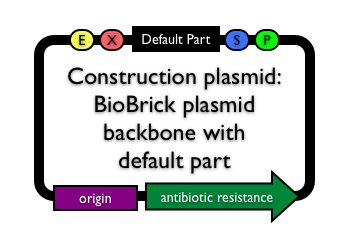Help:Plasmid backbones/Glossary
Plasmids are circular, double-stranded DNA molecules typically containing a few thousand base pairs that replicate within the cell independently of the chromosomal DNA. Plasmids are a convenient way to propagate pieces of DNA, such as BioBrick standard biological parts. Every BioBrick part available via the Registry is maintained on at least one BioBrick plasmid. Sometimes, a part is maintained on multiple BioBrick plasmids, which vary in antibiotic resistance and replication origin (plasmid copy number).
The term "plasmid" can be a bit ambiguous. Here at the Registry, we use the term "plasmid" in three different ways:
- "Plasmid backbone" - the vector alone, WITHOUT any BioBrick part
- "Construction plasmid" - the vector WITH a default BioBrick part(s)
- "Plasmid with any BioBrick part(s)" - the vector WITH some BioBrick part(s).
Plasmid backbone | |

|
Plasmids essentially serve as containers for BioBrick parts. Thus, it is helpful to distinguish between the part itself and container of the part. The term "plasmid backbone" refers to only the vector or "backbone" of the BioBrick part that it propagates. The plasmid backbone includes the BioBrick prefix and suffix, but not any of the part sequence.
pSB1A3, pSB3K3, and BBa_J52017 are all examples of plasmid backbones. These plasmid backbones each have an entry in the Registry, just as a normal BioBrick part does. To find the Registry page of a particular plasmid backbone, enter the plasmid part name (e.g., pSB4K5 or pSB3K3 or pSB1AC3) in the text box at the top right corner of the page and click "Go". |
Construction plasmid | |

|
If you just want one of the BioBrick plasmids, it is probably available in the iGEM DNA distribution with the part
BBa_P1010, BBa_I52001 or BBa_I52002 in the cloning site. You will need the cell strain DB3.1 since each of these three parts constitutively expresses the protein CcdB which is toxic to most strains. When making a brand new BioBrick part, you will need to choose an appropriate BioBrick plasmid (with the right antibiotic resistance marker, copy number etc.) for your construction purposes. To make construction and assembly of BioBrick parts easier, most BioBrick plasmids include the ccdB positive selection marker (encoded in BioBrick parts BBa_P1010, BBa_I52001 and BBa_I52002) by default. The ccdB positive selection marker produces a toxic protein which kills most E. coli strains. Successful insertion of a BioBrick part into a BioBrick vector replaces the ccdB gene and enables cells to grow and divide to form colonies. A common problem during BioBrick part construction and assembly is that BioBrick vectors are not 100% digested when cut with restriction enzymes. The ccdB toxic gene ensures that cells transformed with uncut or religated plasmids do not grow. Thus, any colonies you obtain after a BioBrick part construction or assembly are more likely to be correct.
|
Plasmid with any BioBrick part(s) | |

|
This term refers to a plasmid backbone with one or more BioBrick parts inserted. An example of this can be seen to the left, where a BioBrick part has been inserted into between the BioBrick prefix (denoted by E and X) and the BioBrick suffix (denoted by S and P). |
